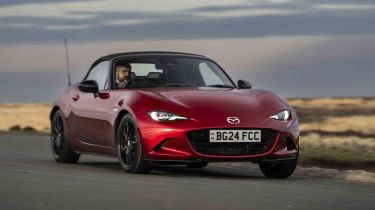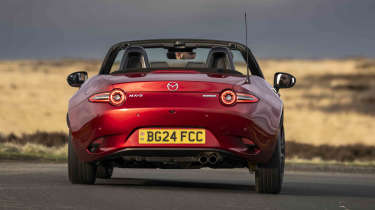Mazda MX-5 - Engines, performance and drive
Rev-happy engines and playful, adjustable chassis results in grin-a-minute drives – even on the most mundane of trips

Back-to-basics driving thrills are what the Mazda MX-5 has always been about – and the latest version doesn’t disappoint. Despite its price, it’s a driver’s car that deserves to be mentioned in the same breath as much more expensive performance cars, including the Porsche Boxster and the Alpine A110.
|
Model |
Power |
0-62mph |
Top speed |
|
1.5L SKYACTIV-G Roadster |
130bhp |
8.3 secs |
127mph |
|
1.5L SKYACTIV-G RF |
130bhp |
8.7 secs |
126mph |
|
2.0L SKYACTIV-G Roadster |
181bhp |
6.5 secs |
136mph |
|
2.0L SKYACTIV-G RF |
181bhp |
6.8 secs |
137mph |
What is the Mazda MX-5 like to drive?
In town
Even at low speeds, it’s a hugely pleasurable thing to drive; from the pedals to the steering to the gearbox, all of the major controls are wonderfully weighted and superbly precise. It’s a car that allows you to appreciate the basics of mechanical interaction on even a short trip to the shops.
Harsher bumps can cause these small, light cars to jostle around at low speeds. It’s at these lower speeds that roof-off driving in either model results in a little flex from the chassis, which manifests itself most obviously through vibrations in the rear view mirror.
On A- and B-roads
It’s on more open roads where the MX-5 really starts to shine, though. With a kerbweight of between 975kg and 1,000kg depending on spec, the Mk4 is over 100kg lighter than the third-generation model, and only 50kg heavier than the original launched back in 1989.
The result is a wonderful chassis, granting the driver a feeling of agility and balance that with every passing year becomes even easier to appreciate as so many cars grow heavier and larger and more ponderous.
Used - available now
The suspension is much more supple than a typical hot hatch, so the car flows along a bumpy road and rolls through the corners. This allows the driver to feel just what is going on through not only the seat of their pants, but also the electric power-steering system; revised for 2024, it has become more naturally weighted than ever before. It doesn’t take too much commitment to play with the car’s limits of grip; normally by throwing it into a bend enthusiastically. Even when the front starts to slide, the mildest throttle lift and a little extra lock will see the car tighten its line further. It’s all so predictable and reassuring – and all happening at such sensible speeds that it inspires a huge amount of confidence, so you only lean on it harder.
Another new-for-’24 feature that helps with this is a revised limited-slip differential. A new cam mechanism has enabled different levels of slip for acceleration and deceleration; in short, what this means is that Mazda has been able to tune the diff to make the car more predictable on the limit.
As before, the differential is only available on the top 2.0-litre model. The 2.0-litre also has bigger brakes than the entry-level 1.5-litre petrol, which deliver better stopping power, plus gets sports suspension with Bilstein dampers and a front strut brace. These reduce body roll and aid turn-in. The 2.0 car is slightly heavier than the 1.5, but only by 25kg. The added weight is in the nose and as a result the 2.0-litre doesn’t feel quite as quick to turn in, even though it's been given a strut brace to keep the suspension tied together.
Like the roadster, the MX-5 RF has a fairly soft overall suspension set-up which allows the driver to flow with the road. The RF also weighs an extra 40kg over the standard car – most of which is fairly high up in the chassis. While this is noticeable when driving the two variants hard and back-to-back – and the 0-62mph times are marginally slower than the lighter roadster variants – most people won’t notice too much difference. However, given the price difference and the fact that in some ways it’s less refined, we’d aim for the soft- top instead.
On the motorway
Perhaps more of a surprise is that, despite the extra metal that surrounds the driver, the RF is the less refined car on the move; the wind tends to catch the upright buttresses behind the driver and passenger, which at motorway speeds generates far more wind noise than the convertible’s more open design. That aside, the MX-5 is a fairly comfortable and relaxing long-distance cruiser, roof up or down.
0-62mph acceleration and top speed
We’ve never craved more power in the MX-5, but with the chassis now better than ever, it’s clear that it could quite reasonably handle more than the 181bhp and 205Nm (at 7,000rpm and 4,000rpm respectively) that’s available here. A 0-62mph time of 6.5 seconds isn’t sluggish, though, but this car is more about conserving momentum – even more so in the 1.5-litre petrol.
Despite a modest 130bhp (again at 7,000rpm) and 152Nm at 4,500rpm, the MX-5’s light weight pays dividends here, giving better performance than you might expect – 0-62mph takes 8.3 seconds. Top speed is 127mph. It’s a lively unit that needs plenty of revs to get to its best – something that it is more than happy to do thanks to its 7,500rpm red line and, as is the case in the 2.0-litre, a fantastic six-speed manual gearbox that is precise and has a wonderfully short throw.
The hard-top RF is available with both engines, but being slightly heavier it takes 8.7 seconds and 6.8 seconds to go from 0-62mph in 1.5 and 2.0-litre forms, respectively.
Whichever you go for, the two engine choices make a revvy, angry noise and just enough exhaust note enters the cabin to remind you that you’re in something sporty. The 1.5 is a little freer revving, but deciding which version has the better character will come down to personal preference.













